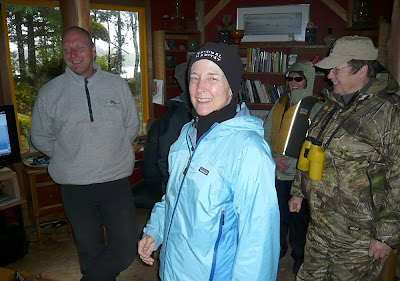Landing on our next beach we came across two grounded and deceased humboldt squid. They are sometimes found this far north when they are following an erratic warm current, but they inevitably die when the warm current disappears.
The posts had evolved a fascinating blend of texture and color out of layering, moisture, plant life, and time.
A short distance from the old house was a beach on the other side of the spit of land. This was obviously the side that accumulated windblown logs.
We spent quite a while on the beach, especially on the mud flats where we birdwatched and inspected all manner of small critters.
Sailing on, we encountered a squad of porpoises, or rather, they decided to check us out. They're fast and hard to get into a photo.
The weather gods smiled on Captain Ian (no sacrifices were made that I know of), and he was able to turn off the motor and cruise down Laredo Sound and Hecate Strait under sail power alone. The Island Roamer reached speeds as high as 7 knots, good for a passenger boat. Everybody basked in the sun and the breeze, although the swells might have caused some to reach for their Bonine.
We anchored behind Day Point Island and sadly began to pack our bags for the next day, departure day. But what a sunrise the next morning; it was an thrilling conclusion to an inspiring trip.Tom stands by the mast in awe of the sun.
You can see the end of our journey in the distance. Goodbye, Great Bear Rainforest, and thank you very much.


















































